Genre: Racing Developer: Sega Ent. Publisher: Sega Ent. Players: 1 Released: 1983
As a fan of Sega since the early 1980s, I’ve always been impressed by the evolution of its racing games. Sega has consistently pushed the envelope of what the genre should be, and while my impressions were mostly focused on visuals and track layouts, I began to take a more nuanced approach as I got older. I soon became more appreciative of the brilliance of Sega’s early racers and how they did more than simply try to simulate driving. They added elements like weather and darkness, taking the experience beyond merely trying to place first. These features went unnoticed by me as a child, but now I have a great love for games like Head-On, Monaco GP, and Turbo.
Monaco GP, despite its namesake association with the prestigious Monaco Grand Prix, began that trend by offering a unique twist on the racing genre, focusing more on driving endurance than traditional head-to-head competition. Set against the backdrop of Monaco’s iconic streets, the game immersed players in the world of Formula 1 racing without direct opponents. Instead, drivers navigated through a bustling field of AI-controlled cars, strategically maneuvering to avoid collisions and maintain momentum. The environments were really dynamic for the time and presented a variety of challenges, from winding streets to treacherous ice-covered roads. The occasional ambulance appeared from behind, marking what was, for me, the first racing experience where obstacles came from the bottom of the screen instead of the top.
What made Monaco GP unique for its time was its progression system, which rewarded players with additional cars (lives) for achieving higher scores. This incentivized skilled driving and encouraged players to work hard to get the highest score, which was really about all you could shoot for at the time. Furthermore, the absence of a time limit allowed for extended play sessions, offering a truly immersive experience where players could test their driving skills to the fullest. This concept may seem simple now, but it was a core component of most arcade titles of the era. Remember, these games were made to eat quarters, so a one actually giving you the means to extend your play time was a carrot too irresistible to refuse.
While the SG-1000 port may have lacked the immersive cockpit cabinet experience of the original arcade version, it faithfully captured the essence of the gameplay with its speed-up-slow-down mechanics. Despite the hardware limitations, Monaco GP on the SG-1000 showcased Sega’s early mastery of arcade-to-console ports, delivering a finely-crafted and enjoyable gameplay experience. According to the ROM file, it was programmed by only two people, a Y. Kawamura and an M. Kidooka, and these gentlemen did a fine job of bringing a cutting-edge arcade game to Sega’s SG-1000. Sure, it was four years later, but it’s still impressive that they were able to create such a faithful port.
So, is it all great? Not exactly. The visuals took a hit during the conversion process, losing detail in the cars and environments, while also suffering a severe reduction in color. It should also be understood that the cockpit model, with its working gauges and digital score meter, was a major part of the game’s attraction. All of that’s gone, of course, in this port.
The gameplay, while great, didn’t hold up for long plays. Let’s be honest; Monaco GP wasn’t the deepest racing game out there, Hell, the instruction manual was a mere six pages from cover to cover. You basically drove until you died, and while that wasn’t complicated, it could be a lot of fun in small doses. That short rush of dopamine was perhaps the game’s main flaw. After a while, there was nothing to keep you coming back too often unless you were playing for the high score. By today’s standards, there wasn’t much meat on these bones, but considering the game was released in 1983, the appeal was definitely understandable. I appreciate it mostly for its attempt to do something different. The fact that it’s still fun to play is a testament to that fact.
Compared to other arcade ports of the era, Monaco GP made its name through focused and pure driving gameplay. Unlike some of Sega’s other titles, such as Congo Bongo or Sindbad Mystery, which felt derivative and lacking in innovation, Monaco GP demonstrated Sega’s ability to innovate and set the stage for future racing classics like Daytona USA and Sega Rally. It may not have offered the intense competition and deeper features of traditional racing games, but its emphasis on driving endurance and skillful navigation made it a standout title in Sega’s early arcade lineup. With its challenging gameplay, immersive atmosphere, and solid mechanics, Monaco GP showed how Sega laid a great foundation for its future success in the racing genre.

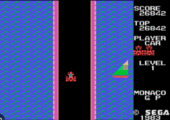
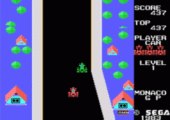
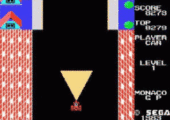
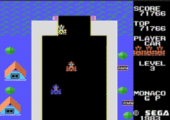
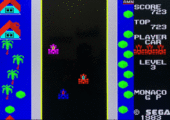
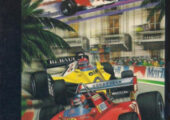
Recent Comments